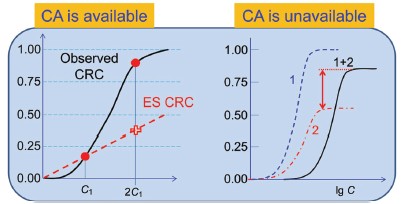| [1] Backhaus, T.; Faust, M. Environ. Sci. Technol. 2012, 46(5), 2564. [2] Vacchi, F. I.; Albuquerque, A. F.; Vendemiatti, J. A.; Morales, D. A.; Ormond, A. B.; Freeman, H. S.; Zocolo, G. J.; Zanoni, M. V. B.; Umbuzeiro, G. Sci. Total Environ. 2013, 442, 302. [3] Spurgeon, D. J.; Jones, O. A. H.; Dorne, J. L. C. M.; Svendsen, C.; Swain, S.; Sturzenbaum, S. R. Sci. Total Environ. 2010, 408(18), 3725. [4] Dominguez-Cortinas, G.; Diaz-Barriga, F.; Isabel Martinez-Salinas, R.; Cossío, P.; Nelinho Pérez-Maldonado, I. Environ. Sci. Pollut. Res. 2013, 20(1), 351. [5] Berenbaum, M. J. Theor. Boil. 1985, 114, 413. [6] Cedergreen, N.; Christensen, A. M.; Kamper, A.; Kudsk, P.; Mathiassen, S. K.; Streibig, J. C.; Sorensen, H. Environ. Toxicol. Chem. 2008, 27(7), 1621. [7] Martin, H. L.; Svendsen, C.; Lister, L. J.; Gomez-Eyles, J. L.; Spurgeon, D. J. Environ. Toxicol. Chem. 2009, 28(1), 97. [8] Silva, E.; Rajapakse, N.; Scholze, M.; Backhaus, T.; Ermler, S.; Kortenkamp, A. Toxicol. Sci. 2011, 122(2), 383. [9] Porsbring, T.; Backhaus, T.; Johansson, P.; Kuylenstierna, M.; Blanck, H. Environ. Toxicol. Chem. 2010, 29(12), 2806. [10] Bosgra, S.; van Eijkeren, J. C. H.; Slob, W. Crit. Rev. Toxicol. 2009, 39(5), 418. [11] Fischer, B. D. CNS Neurol. Disord.-Drug Targets 2011, 10(5), 529. [12] Abendroth, J. A.; Blankenship, E. E.; Martin, A. R.; Roeth, F. W. Weed Technol. 2011, 25(3), 436. [13] Backhaus, T.; Arrhenius, A.; Blanck, H. Environ. Sci. Technol. 2004, 38(23), 6363. [14] Backhaus, T.; Faust, M.; Scholze, M.; Gramatica, P.; Vighi, M.; Grimme, L. H. Environ. Toxicol. Chem. 2004, 23(2), 258. [15] Liu, S. S.; Zhang, J.; Zhang, Y. H.; Qin, L. T. Acta Chim. Sinica 2012, 70, 1511. (刘树深, 张瑾, 张亚辉, 覃礼堂, 化学学报, 2012, 70, 1511.)[16] Liu, S. S.; Song, X. Q.; Liu, H. L.; Zhang, Y. H.; Zhang, J. Chemosphere 2009, 75, 381. [17] Wang, L. J.; Liu, S. S.; Yuan, J.; Liu, H. L. Chemosphere 2011, 84, 1440. [18] Rylee, P. D.; Stahlhut, R. W.; Ponzi, D.; vom Saal, F. S.; Taylor, J. A. Reprod. Toxicol. 2012, 34(4), 614. [19] Andrade, A. J. M.; Grande, S. W.; Talsness, C. E.; Gericke, C.; Grote, K.; Golombiewski, A.; Sterner-Kock, A.; Chahoud, I. Toxicology 2006, 227(3), 185. [20] Zhu, X. W.; Liu, S. S.; Qin, L. T.; Chen, F.; Liu, H. L. Ecotox. Environ. Safety 2013, 89, 130. [21] Conolly, R. B.; Lutz, W. K. Toxicol. Sci. 2004, 77, 151. [22] Jenkins, S.; Wang, J.; Eltoum, I.; Desmond, R.; Lamartiniere, C. A. Environ. Health. Perspect 2011, 119, 1604.[23] Vandenberg, L. N.; Colborn, T.; Hayes, T. B.; Heindel, J. J.; Jacobs, D. R., Jr.; Lee, D. H.; Shioda, T.; Soto, A. M.; vom Saal, F. S.; Welshons, W. V.; Zoeller, R. T.; Myers, J. P. Endocr. Rev. 2012, 33, 378. [24] Silva, E.; Rajapakse, N.; Kortenkamp, A. Environ. Sci. Technol. 2002, 36(8), 1751. [25] Faust, M.; Altenburger, R.; Backhaus, T.; Blanck, H.; Boedeker, W.; Gramatica, P.; Hamer, V.; Scholze, M.; Vighi, M.; Grimme, L. H. Aquat. Toxicol. 2001, 56(1), 13. [26] Ge, H. L.; Liu, S. S.; Zhu, X. W.; Liu, H. L.; Wang, L. J. Environ. Sci. Technol. 2011, 45, 1623. [27] Loewe, S. Arzneimittelforschung 1953, 3, 285.[28] Berenbaum, M. C. Adv. Cancer Res. 1981, 35, 269. [29] Tallarida, R. J. J. Pharmacol. Exp. Therap. 2006, 319(1), 1. [30] Rodea-Palomares, I.; Petre, A. L.; Boltes, K.; Leganes, F.; Perdigon-Melon, J. A.; Rosal, R.; Fernandez-Pinas, F. Water Res. 2010, 44(2), 427. [31] Sorensen, H.; Cedergreen, N.; Skovgaard, I. M.; Streibig, J. C. Environ. Ecol. Stat. 2007, 14(4), 383. [32] Zhu, X. W.; Liu, S. S.; Ge, H. L.; Liu, Y. China Environ. Sci. 2009, 29(2), 113. (朱祥伟, 刘树深, 葛会林, 刘堰, 中国环境科学, 2009, 29(2), 113.)[33] Baldwin, W. S.; Roling, J. A. Toxicol. Sci. 2009, 107(1), 93. [34] Cedergreen, N.; Christensen, A. M.; Kamper, A.; Kudsk, P.; Mathiassen, S. K.; Streibig, J. C.; Sorensen, H. Environ. Toxicol. Chem. 2008, 27(7), 1621. [35] Wang, Z.; Chen, J. W.; Huang, L. P.; Wang, Y.; Cai, X. Y.; Qiao, X. L.; Dong, Y. Y. Chemosphere 2009, 74(5), 735. [36] Ermler, A. J.; Spurgeon, D. J.; Svendsen, C.; Griffin, J. L.; Swain, S. C.; Sturzenbaum, S. R.; Jones, O. A. H. Ecotoxicology 2012, 21(5), 1436.[37] Christen, V.; Crettaz, P.; Oberli-Schraemmli, A.; Fent, K. Toxicol. Appl. Pharmacol. 2012, 259(2), 169.[38] Ermler, S.; Scholze, M.; Kortenkamp, A. Toxicol. Appl. Pharmacol. 2011, 257(2), 189.[39] Zhang, J.; Liu, S. S.; Zhang, J.; Qin, L. T.; Deng, H. P. J. Hazard. Mater. 2012, 239~240, 102. [40] Backhaus, T.; Scholze, M.; Grimme, L. H. Aquat. Toxicol. 2000, 49(1~2), 49.[41] Altenburger, R.; Backhaus, T.; Boedeker, W.; Faust, M.; Scholze, M.; Grimme, L. H. Environ. Toxicol. Chem. 2000, 19(9), 2341. [42] Backhaus, T.; Altenburger, R.; Boedeker, W.; Faust, M.; Scholze, M.; Grimme, L. H. Environ. Toxicol. Chem. 2000, 19(9), 2348. [43] Olmstead, A. W.; LeBlanc, G. A. Aquat. Toxicol. 2005, 75(3), 253. [44] Mo, L. Y.; Liu, S. S.; Liu, H. L. China Environ. Sci. 2008, 28(4), 334. (莫凌云, 刘树深, 刘海玲, 中国环境科学, 2008, 28(4), 334.)[45] Ge, H. L.; Liu, S. S.; Liu, F. Asian J. Ecotoxicol. 2006, 1(4), 295. (葛会林, 刘树深, 刘芳, 生态毒理学报, 2006, 1(4), 295.)[46] Payne, J.; Rajapakse, N.; Wilkins, M.; Kortenkamp, A. Environ. Health Perspect. 2000, 108(10), 983. [47] Song, X. Q.; Liu, S. S.; Liu, H. L.; Ge, H. L. Asian J. Ecotoxicol. 2008, 3(3), 237. (宋晓青, 刘树深, 刘海玲, 葛会林, 生态毒理学报, 2008, 3(3), 237.)[48] Villa, S.; Migliorati, S.; Monti, G. S.; Vighi, M. Ecotoxicol. Environ. Safety 2012, 86, 93. [49] Barata, C.; Fernandez-San Juan, M.; Feo, M. L.; Eljarrrat, E.; Soares, A. M. V. M.; Barcelo, D.; Baird, D. J. Environ. Sci. Technol. 2012, 46(17), 9663. [50] Neuwoehner, J.; Fenner, K.; Escher, B. I. Environ. Sci. Technol. 2009, 43(17), 6830.[51] Altenburger, R.; Nendza, M.; Schuurmann, G. Environ. Toxicol. Chem. 2003, 22(8), 1900. |
